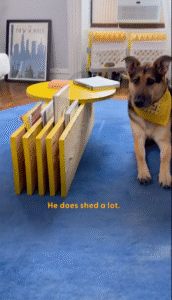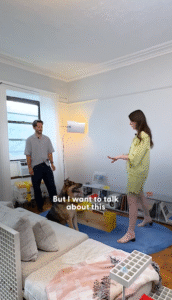
Sarah’s sudden declaration about the table startled Mark from his morning newspaper perusal. She stood before the modest wooden piece with the reverence of a museum curator presenting a lost masterpiece. “This,” she announced with dramatic flair, “isn’t just some assembly-line particle board atrocity.” Her fingers traced the whorls in the grain as if reading braille. “See how the natural imperfections tell its story? The subtle variations in tone create visual movement that draws the eye without overwhelming the space.” Mark blinked, struggling to reconcile her poetic description with the perfectly ordinary side table he’d barely noticed before. Sarah continued her soliloquy, now crouching to examine the joinery. “The craftsmanship here shows someone understood wood as a living material – these slight irregularities aren’t flaws, they’re character marks.” As she waxed lyrical about chamfered edges and the perfect stain opacity, Mark made a mental note to pay more attention to their furniture.
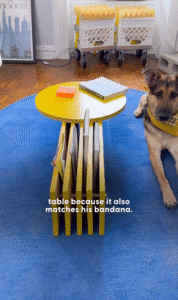
When Canine Fashion Meets Furniture Finishes
With the energy of a forensic investigator making a breakthrough, Sarah suddenly scooped up their drowsy golden retriever. “The proof is in the plaid!” she declared, aligning Baxter’s bandana with the table’s surface. Mark watched, bemused, as his wife became increasingly animated about the shared color palette. “The navy threads in this fabric pick up the cooler undertones in the wood’s finish, while the caramel stripes mirror the warmer base notes,” she explained with the seriousness of an art historian. Baxter, accustomed to being used as a living prop, sighed dramatically but tolerated the impromptu fashion show. Sarah rotated him slightly for better lighting. “It’s not just color matching – it’s about complementary textures too. The bandana’s crisp cotton plays off against the wood’s organic roughness.” Mark opened his mouth to question this analysis when Sarah added triumphantly, “And the white in the pattern ties back to the wall color! It’s a complete design ecosystem!”
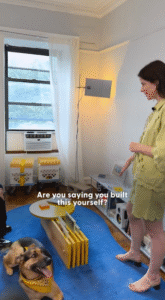
Confessions of a Closet Carpenter
The atmosphere shifted when Sarah casually mentioned, “Of course, I’d notice these details – I built it.” The silence that followed was so complete they could hear Baxter’s tail thumping against the floor. Mark’s face cycled through expressions like a slot machine before landing on stunned disbelief. “You… constructed… this?” he managed, suddenly seeing the table with new eyes. Sarah nodded, suddenly shy about her accomplishment. “Last summer when you were at that conference. I needed a project.” As Mark examined the piece with fresh perspective, Sarah pointed out subtle tells of amateur craftsmanship – the slightly uneven drawer alignment, the visible glue line at one joint. “This corner here?” She indicated a barely noticeable imperfection. “That’s where I learned why wood filler exists.” Her tone turned conspiratorial. “And between us? The plans called for dovetail joints. These are… creative interpretations of dovetails.” Mark ran his hand along the edge, imagining his accident-prone wife wielding power tools, and felt simultaneous pride and terror.
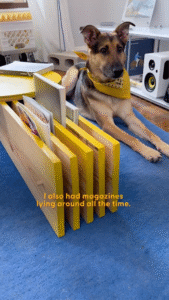
Defending the Magazine Ecosystem
Sarah gestured to the carefully arranged periodicals gracing the table’s lower shelf. “This isn’t just random piles,” she insisted, adjusting a home decor magazine to better display its cover. “It’s a curated collection that serves multiple purposes.” Mark raised a skeptical eyebrow as she explained her organizational system. “Top layer is current inspiration – things I’m actively referencing. Middle layer is aspirational – projects for someday. Bottom is archival – proven winners.” She demonstrated how the staggered arrangement created visual interest while maintaining accessibility. “And see how I’ve color-coordinated the spines? Warm tones to the left, cool to the right.” When Mark pointed out that Baxter’s wagging tail regularly disrupted this system, Sarah shrugged. “That’s part of the charm! A living space should show signs of life.” She paused thoughtfully. “Though I will admit the ‘Baxter nose art’ on the lower corners does complicate my filing system.”
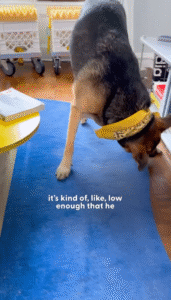
Designing for Optimal Dog Comfort
The table’s true purpose became clear when Baxter, with the practiced ease of a seasoned opportunist, rested his massive head on its surface. “Observe,” Sarah whispered, as if witnessing rare wildlife behavior. “The exact perfect height for chin support.” Mark watched, equal parts amused and disgusted, as a long strand of drool began its inevitable descent toward the wood grain. Sarah, however, saw only successful design. “Most furniture forces dogs into uncomfortable positions,” she explained while mopping up saliva with a practiced hand. “But this elevation allows natural alignment of his spine while keeping him engaged with human activities.” She demonstrated how the height accommodated everything from casual petting to treat distribution. “And notice the rounded corners?” she added, pointing to the edges. “No sharp angles to bump his elbows during nap transitions.” Mark opened his mouth to protest the furniture’s apparent primary user, but was interrupted by Baxter’s contented sigh as he settled in for a proper table-top snooze
The Geometry of Conversation:
Sarah assumed what she called “the position” – elbows resting comfortably on the table’s surface, shoulders relaxed, hands free to gesture or hold beverages. “This,” she declared, “is social engineering at its finest.” Mark reluctantly mirrored her stance and had to admit the geometry worked. “The height creates intimacy without crowding,” Sarah explained, shifting to demonstrate different interaction scenarios. “For serious talks, you can lean in close.” She demonstrated, then adjusted. “For casual chats, you can recline slightly.” Another adjustment. “And for dramatic announcements,” she struck a pose, “you’ve got perfect support for emphatic gestures.” Mark noted how the table indeed seemed to accommodate everything from morning coffee routines to late-night heart-to-hearts. “You’ve essentially designed the furniture equivalent of Switzerland,” he observed. “Neutral territory that works for any occasion.” Sarah beamed at this assessment, clearly pleased her intentions had been understood
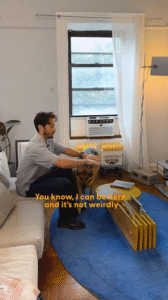
The Economics of Self-Sufficiency: A Cost-Benefit Analysis
The conversation turned practical when Mark asked about the financial upside of DIY. Sarah produced a well-worn notebook filled with calculations. “Let’s break it down,” she said, slipping into what Mark called her “Ted Talk voice. The spreadsheet (because of course she made a spreadsheet) compared retail prices for similar pieces against her actual material costs. “The real savings come from eliminating the designer markup,” she explained, pointing to a particularly staggering number from a high-end catalog. But the analysis went deeper – she’d factored in tool acquisition (amortized over future projects), time investment (calculated at both contractor rates and her actual hourly wage), and even the “intangible value of personal satisfaction.” Mark scanned the detailed breakdown with growing admiration. “You even accounted for the Band-Aids,” he noted, seeing line items for first aid supplies. Sarah nodded solemnly. “Occupational hazard. Though I may have underestimated the emotional toll of sanding-related carpal tunnel.” The final tally showed an impressive savings, even after accounting for what she termed “the education premium” of beginner mistakes.
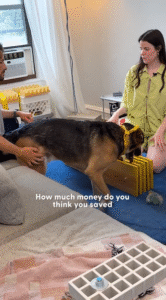
- Textile Appreciation: The Rug as Unifying Design
Element Without warning, Sarah descended to the floor, stretching out on the living room rug with the abandon of a child making snow angels. “This,” she proclaimed to the ceiling, “is the unsung hero of our decor.” Baxter immediately joined what appeared to be becoming a group meditation session. “The rug isn’t just a rug – it’s the visual glue connecting all elements in the room.” She pointed out how its pattern picked up tones from both the table and the walls, how its texture complemented the sofa fabric, how its dimensions created the perfect conversational zone. “And functionally,” she added, nuzzling her face into the pile, “it provides exceptional napping real estate.” Mark watched this performance with amused resignation. “I feel like we’ve moved beyond interior design into some kind of textile-based mindfulness practice,” he observed. Sarah sat up, plucking a dog hair from her lip. “Good design should engage all the senses,” she countered, running her fingers through the fibers. “Touch is just as important as sight.” Baxter sneezed in agreement.
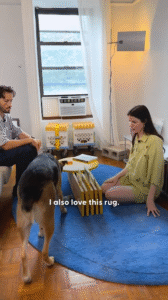
The Shedding Situation: Embracing the Canine Glitter
The discussion inevitably turned to what Mark called “the Baxter glitter” – the ever-present golden fur that coated every surface. Sarah, ever the optimist, framed it as a design feature. “It’s nature’s way of accessorizing,” she claimed, plucking a tuft from the table’s surface and watching it float away. Mark produced evidence from his coffee cup – a perfect paw-shaped collection of hairs floating on the surface. “I’m pretty sure we could reconstruct Baxter from the fur deposits around this house,” he grumbled. Sarah, however, saw beauty in the chaos. “It’s a living record of where he’s been,” she mused, tracing a path of hairs along the rug. “Like fuzzy breadcrumbs marking his daily adventures.” She even argued it served a practical purpose: “Nothing makes a house feel like a home faster than pet hair on every horizontal surface.” When Mark pointed out this wasn’t typically listed in design magazines as a desirable feature, Sarah shrugged. “Those magazines don’t understand authentic lived-in aesthetics.” As if to emphasize her point, Baxter shook vigorously, sending a fresh wave of golden “glitter” into the air, where it caught the sunlight like tiny autumn leaves before settling gently on the now officially “lived-in” table.
